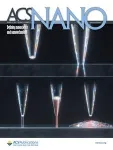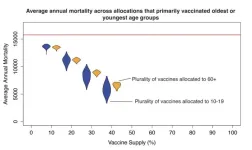(Press-News.org) Dr. Jaeyeon Pyo of the Smart 3D Printing Research Team at the Korea Electrotechnology Research Institute (KERI) has developed a breakthrough technology that uses light to visualize nanoscale glass microcapillary tips, enabling precise and delicate contact with other objects.
A “‘Microcapillary” is a precision tool with a very small aperture (0.1 mm to 0.000010 mm in diameter) fabricated from a glass tube. It is utilized as a vital tool in various fields, from biotechnology to manipulate cells, to micro electroplating and nano 3D printing. Specifically, it is used in biotechnology faor tasks such as injecting sperm into an egg during in vitro fertilization (IVF) or as a tool for penetrating cell membranes to study cellular mechanisms*. In electroplating, it allows metal plating within extremely small areas, which is useful for manufacturing precision electronic circuits or microstructures. It can also be used as a 3D printing nozzle to print ultra-fine structures in three dimensions.
* Mechanism: The basis that causes the physiological function of an organism.
A primary concern in utilizing microcapillaries is to ensure delicate and precise contact at the sharp tip so that the glass microcapillary does not break or the target object is not damaged. In the past, contact was determined by observing with an optical microscope, but for nanoscale ultra-fine microcapillaries, contact could not be determined due to the diffraction-limited resolution. Although other methods, such as monitoring electrical current or mechanical vibrations have been employed, their versatility is constrained by material specificity (limited to conductive materials) or by interference that can potentially influence the results.
The new method developed by Dr. Jaeyeon Pyo's team utilizes 'light.' When light is projected into a glass microcapillary tube, the light travels through the tube to the sharp end tip. When the tip does not touch an object, a bright scattering light is observed, and the moment it touches an object, it immediately disappears. This simple method, which only requires one light source to surpass the resolution limits of optical microscopes for contact detection, is a remarkable achievement that cannot be accomplished without a comprehensive understanding of the light-matter interactions at the nanoscale.
The research team discovered through various experiments and simulations that light, which had been transmitted in the form of an evanescent wave, is not scattered at the tip upon contact, but rather transmitted to the object it contacts. To validate the applicability of this technology, they showcased the precise contact detection capabilities of the micro-glass tube in various fields, including ▲nano 3D printing processes, ▲micro copper electroplating processes and clogging solutions, and ▲the invasion of cell walls in oral epithelial cells, confirming its accurate and immediate detection performance.
Through various experiments and simulations, the research team discovered that the light, which is propagating in the form of an evanescent wave, is transferred to the object that has come into contact rather than being scattered at the tip.
To validate the applicability of this technology, the team demonstrated the delicate contact of microcapillaries in various fields, such as ▲the nanoscale 3D printing process, ▲the micro electroplating process of copper, solving the clogging of nozzles, and ▲the invasion of membranes of oral epithelial cells, confirming its precise and immediate detection performance.
The research, recognized for its excellence, was published as a cover article in ACS Nano, a top-tier SCI journal in the field of nanoscience, published by the American Chemical Society. The journal’s JCR Impact Factor is 15.8, placing it in the top 5.9% of its field.
Dr. Jaeyeon Pyo explained the background of the research, stating, “As the previously developed nanoscale 3D printing process, based on optical microscopic observation, faced physical limitations, a completely new approach was needed to improve the resolution, stability, and yield.” He added, “With an understanding of optical physics at the nanoscale, we came up with a groundbreaking idea to utilize the 3D printing nozzle as a tool for monitoring its contact, which led to successful results.”
Having completed the patent application for the original technology, KERI expects this breakthrough to attract significant interest from various research institutes and industries that require nanoscale precision processes, such as 3D printing, displays, biotechnology, electroplating, and microelectronics. The simplicity of the technology, which can be implemented by using just a single light source without material or environmental limitations, suggests a wide range of potential applications. Dr. Jaeyeon Pyo’s team plans to further demonstrate and validate its applicability in more fields, actively discover companies in demand, and pursue technology transfer.
Meanwhile, KERI is a government-funded research institute under the National Science and Technology Research Council of the Ministry of Science and ICT. This research was supported by KERI’s Primary research program, ‘Development of 4D Printing Technology for Circuits/Housing Integrated Devices.’ Dr. Jaeyeon Pyo is also an associate professor at the Korea University of Science and Technology (UST).
END
Light-based microcapillary monitoring sparks innovation in manufacturing and biotechnology
2024-10-01
ELSE PRESS RELEASES FROM THIS DATE:
Global effort to map the human brain releases first data
2024-10-01
Seattle, WA – October 1, 2024 – The BRAIN Initiative® Cell Atlas Network (BICAN) has launched its first major data release, marking a significant milestone in the ambitious effort to map the whole human brain.
The data, accessible through the BICAN Rapid Release Inventory, includes single-cell and single-nucleus transcriptomic and epigenomic profiles from humans, mice, and 10 other mammalian species. Sourced from multiple grants and labs within the consortium, including the Allen Institute, these data are from projects that aim to identify and define brain cell types based on molecular profiles.
“The ...
Scientists discover planet orbiting closest single star to our Sun
2024-10-01
Using the European Southern Observatory’s Very Large Telescope (ESO’s VLT), astronomers have discovered an exoplanet orbiting Barnard’s star, the closest single star to our Sun. On this newly discovered exoplanet, which has at least half the mass of Venus, a year lasts just over three Earth days. The team’s observations also hint at the existence of three more exoplanet candidates, in various orbits around the star.
Located just six light-years away, Barnard’s star is the second-closest stellar system — after Alpha Centauri’s three-star group — and the closest individual star to us. Owing to its proximity, it is a primary target in ...
New ACS report: Breast cancer mortality continues three decade decline overall, but steeper increases in incidence for women
2024-10-01
The American Cancer Society (ACS) today released Breast Cancer Statistics, 2024, the organization’s biennial update on breast cancer occurrence and trends in the United States. The new report finds breast cancer mortality rates overall have dropped by 44% since 1989, averting approximately 517,900 breast cancer deaths. However, not all women have benefited from this progress, notably American Indian and Alaska Native (AIAN) women, whose rates have remained unchanged over the past three decades. Also concerning ...
Immigrants to the United States still assimilate
2024-10-01
Children of immigrants to the United States typically incorporate themselves into US economic and cultural life, and this pattern of assimilation has not markedly changed in over a century. Today, one in seven US residents was born abroad, rates similar to those seen in the late nineteenth century. As immigrants’ countries of origin have shifted from Europe to Asia and the Americas, a narrative has developed that contemporary immigrants do not assimilate as thoroughly as older immigrants. But is this true? In a Perspective, Ran Abramitzky and Leah Boustan summarize their long-running research program matching individuals across historical US Censuses. The authors compare ...
Vaccinating the young to save the old in the Tropics
2024-10-01
A model suggests that vaccinating children and teens against the flu can help protect the elderly in tropical countries. Influenza kills up to 650,000 people worldwide every year. In part due to the lack of strong seasonality and differences in vaccine supply, optimal vaccination strategies for the tropics may differ from those in temperate zones. Joseph Servadio and colleagues parameterized an age-structured mathematical model of influenza transmission to the asynchronous, non-annual epidemiology of tropical influenza in Vietnam, a country with low vaccine coverage. The model includes three subtypes of the flu virus. Vaccinating year-round was found to be ...
Climate change, drought, dust, and plankton blooms
2024-10-01
A study links an unusual plankton bloom off the coast of Madagascar to drought in Southern Africa. Climate warming has intensified droughts around the world. When vegetation dies from lack of water, the wind can pick up and carry unprotected soil particles for thousands of kilometers. These dust particles can then act as fertilizer when deposited in seawater. Dionysios Raitsos and colleagues show that dust from drought-stricken Southern Africa caused a bloom of marine phytoplankton off the southeast Madagascar coast from November 2019 through February 2020. The team used standardized anomalies of dust aerosol optical depth from the Copernicus ...
Nudges fail to reduce online hate
2024-10-01
Seven nudges aiming to reduce hateful speech online all failed—but the nudges unexpectedly succeeded in increasing engagement with harmless and wholesome content. Controlling hate speech is an ongoing challenge for online communities. In a pre-registered experiment, Tatiana Celadin and colleagues compared the effects of seven “nudges,” messages designed to promote prosocial behaviors: reminding posters of descriptive norms, injunctive norms, or personal norms; cooling down negative emotions; stimulating deliberation or empathy; and highlighting reputation. Over 4,000 Americans recruited through the online platform ...
NMR-guided optimization of lipid nanoparticles for enhanced siRNA delivery
2024-10-01
Small interfering RNA (siRNA) molecules hold immense potential for treating diseases by silencing specific genes. Encapsulated in lipid nanoparticles (LNPs), siRNA can be delivered efficiently to target cells. However, the effectiveness of these therapies hinges on the internal structure of the LNPs, which can significantly impact their ability to deliver siRNA. Traditional methods often fall short in providing the detailed molecular insights needed to fine-tune LNP design for optimal therapeutic efficacy.
A study published in the Journal of Controlled Release on August 02, 2024, led by Assistant Professor Keisuke Ueda from ...
Mount Sinai leaders receive prestigious awards during the American College of Emergency Physicians 2024 Scientific Assembly (ACEP24)
2024-10-01
Mount Sinai Health System’s Chief Executive Officer (CEO) and the Emergency Department Chair at Mount Sinai Queens have been recognized with top honors for their outstanding achievements at the American College of Emergency Physicians (ACEP) 2024 Scientific Assembly in Las Vegas during a special ceremony on Monday, September 30.
Brendan G. Carr, MD, MS, FACEP, CEO, Professor and Kenneth L. Davis, MD, Distinguished Chair of the Mount Sinai Health System, received the Colin C. Rorrie, Jr, PhD Award for Excellence in Health Policy.
This award is an extraordinary ...
Women more likely to choose wine with feminine labels
2024-10-01
PULLMAN, Wash. – To appeal to the majority of consumers, winemakers may want to pay as much attention to what’s on the bottle as what’s in it.
A three-part experimental study led by Washington State University researchers found that women were more inclined to purchase wine that had labels with feminine gender cues. The more strongly the participants identified with other women, a phenomenon called “in-group identification,” the greater this effect was. A feminine label also influenced their expectation that they would like the wine better.
With women representing 59% ...









